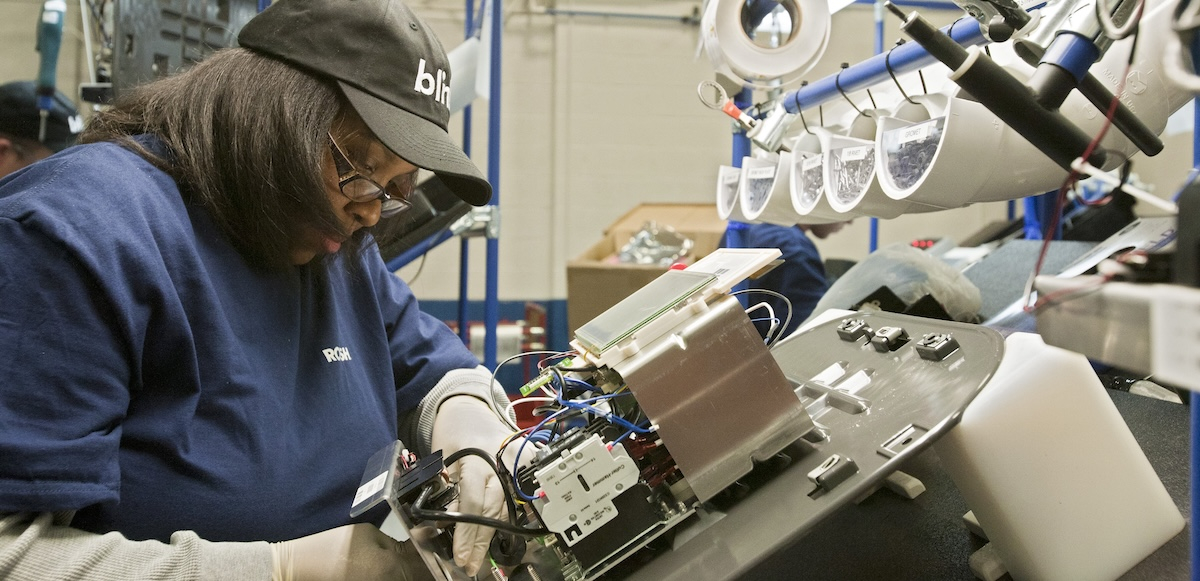Stewards Corner: Organizing to ‘Green’ Your Job: What Works?

A worker assembles an electrical vehicle charging station at Roush Manufacturing in Livonia, Michigan. Photo: Jim West, jimwestphoto.com
Stewards often build fights around small issues, and they need to. But stewards also have a special charge to stay ahead of the boss—to think big about shifting power on the job, including by driving the move to green production.
The union can fight smarter when it’s not just reacting to the boss’s plans—when members have talked over their own goals for making work different.
The first task is to open up talk beyond the usual suspects. No matter the good intentions, passing resolutions and creating isolated green committees doesn’t flex much worker power. It takes wide participation to identify common goals, specific work processes that have to change, and friction points to push management.
PLOTTING THE COURSE
Aviation union members in England and Quebec have been trying out “worker assemblies” to plot their own course for the industry.
Few industries have a cloudier future than aviation. Mid-size planes fly less than a mile per gallon of jet fuel, and so far green replacements are expensive hot air. Laws to cut pollution could become an excuse for bosses to cut jobs. Climate chaos is already causing riskier turbulence for flight crews.
Workers are concerned that management has no real plan to address those problems. “I thought industry was willing to change from within, then I gradually realized how much greenwash there was,” said British former pilot George Hibberd. (Greenwashing means making a company’s practices or products look more eco-friendly than they are.)
“I joined an environmental committee in my union, but we were an ultra-minority,” he said. “The official union approach then was, ‘We need climate action, but anyone but us.’”
So Hibberd and other aviation workers formed the group Safe Landing. In 2023, they held a three-hour workshop in the airplane engineering hub of Bristol. The organizers chipped in a stipend for workers to join. Thirty workers learned from a few tech experts about challenges and prospects for greening their planes, then debated the best course.
The goal, Hibberd said, is to grow to big assemblies of members, picked jury duty-style from their unions, that come up with a “national industry plan” to demand action from bosses and politicians. “We want to give workers the opportunity to decide how their industry moves forward,” he said, “rather than blindly following what their boss says.”
FOR US, FOR THE WORLD
Inspiration from that workshop has spread to Quebec, where 20 Unifor members and officers at a major Bombardier private jet factory, helped by the group Workers for Climate Justice (Travailleuses et Travailleurs pour la Justice Climatique), held an all-day session last November.
Airplane builders discussed the risks to their jobs from climate disasters on the one hand, and rapid policy changes on the other. They made sticky notes indicating which parts of their jobs they wanted to keep or change, and put them on an X-Y chart: one axis was “important for us,” the other, “important for the world.”
Then they sketched five changes they wanted in their next union contract; one was to mandate a union seat on the corporate board to “overcome the culture of secrecy.” They called for a national summit of aviation workers on the industry’s future, and urged unions to create space for worker training and debate “to allow members to take ownership of these issues.”

SUPPORT LABOR NOTES
BECOME A MONTHLY DONOR
Give $10 a month or more and get our "Fight the Boss, Build the Union" T-shirt.
Workers for Climate Justice is planning similar workshops with union members at Quebec’s main gas company and a major wood processing plant.
PICKING A RIPE TIME
The best shot for workers to turn the blueprints green often comes when an industry is booming and hungry for more hands. Australian construction workers and bulldozer drivers in the 1970s began refusing to bulldoze forests or workers’ homes as part of a movement that became known as the “Green Bans.” A skyscraper rush helped give them leverage to organize new members, democratize their union, then strike.
On the flipside, looming closures and layoffs can inspire talk about conversion. When Britain’s Lucas Aerospace Company announced restructuring and job cuts in 1974, shop stewards solicited alternative ideas from workers. They came up with detailed plans to make an array of socially useful products, including heat pumps, solar panels, wind turbines, and streetcars. Company owners ultimately chose to shut down rather than take up those plans.
In the same vein, a General Motors shutdown in Ontario in 2019 drove auto workers and allies to launch Green Jobs Oshawa, a campaign to build electric trucks at their plant, especially for Canada’s mail fleet. But as the workers in Oshawa found, closures also tend to thin out a union’s workplace power, so pushing for community action and government funding becomes critical.
START ON THE RIGHT FOOT
Another promising moment is when industries are just getting off the ground. Management often doesn’t know what it’s doing, so the work process can be up for grabs. That’s what workers at Ford BlueOval and GM Ultium electric vehicle battery factories are learning (see page 6).
They’re building support for their union drive as they fight for safety and environmental standards in this emerging industry. Although electric vehicles cut in half the lifetime climate pollution of gasoline cars, battery facilities are plagued by chemical leaks, electric shocks, explosions, and fires.
In the 1970s, members of the U.S. Oil, Chemical, and Atomic Workers enlisted doctors and scientists to tour their plants to track the toxins that workers were exposed to. Union leader Tony Mazzocchi had the insight that workplace safety is closely linked to environmental pollution—if an industry is releasing toxins into the environment, it’s probably exposing workers first and worst. Scientists went on to organize with the union to win new health and safety laws; that’s how we got OSHA.
Today, new laws and management plans for green transitions are a double-edged sword for worker power. CEOs may seize on disruption as an excuse for union-busting, outsourcing, or layoffs. But these shakeups can also offer a chance for unions to change our industries on workers’ terms, for the planet we deserve.
Climate Talk: Get Started
To learn what matters to your co-workers, start by asking questions. Here are some good ones:
- How have extreme weather events, like wildfires, floods, heat waves, ice storms, or something else affected your job or industry already?
- What would you change about your job to make it better for you? What would you change to make it better for the climate?
- How is management trying to change our work instead? How are management’s priorities different from workers’ needs when it comes to addressing climate change?
Come talk through these questions and more at our Steering Green Transitions workshop. The next one is on Zoom on April 23, 8 p.m. Eastern. Register here.
For more content from the April 2025 Jobs and Climate special issue, go here.





